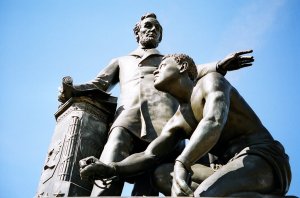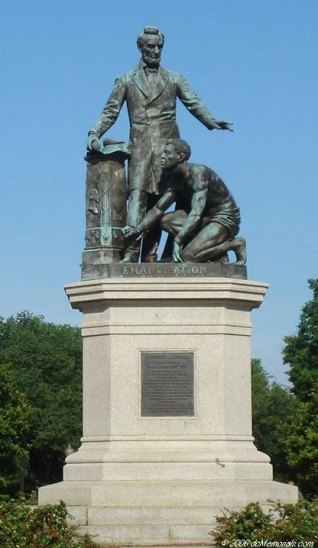
Artist: Thomas Ball
This commentary will discuss the cultural and historical relationship between the literary text Narrative of the Life of Frederick Douglas, An American Slave, Written by Himself[1] and the ‘Emancipation Memorial’[2] erected in 1876 in Washington, D.C; also known as the ‘Freedman’s Memorial’. The first version of the text, published in 1845, was written during the antebellum period in contrast to the monument that was erected towards the end of the Reconstruction, when the position of black Americans was supposed to have altered with the Emancipation Declaration in 1863. However, it can be argued that many of Douglas’s main preoccupations with the racial prejudices during the antebellum era can be seen embodied in the sculpture that was intended to commemorate ‘The Emancipator’, and the emancipation. My aim is to compare the representation of the African-American in both of these products of material culture and highlight the most thought-provoking differences, in order to further understand the complex network of racial discrimination that remained in place between the publication of the book and the erection of the sculpture. The ‘Emancipation Memorial’ begins with Charlotte Scott, a former slave, who, upon hearing of President Lincoln’s assassination donated five dollars to aid in building a monument to commemorate the martyr-president.[3] The cause was passed over to the Western Sanitary Commission of St. Louis, led by William G. Elliot. In an attempt to attract further donations from freedmen around the country the commission reported in their first broadside that an ‘old negro woman’ had donated money to build a ‘monument to good Massa Lincoln’[4]. This idealistic interpretation of Scott’s donation – taken as a model gesture of black gratitude – became permanently attached to the fundraising campaign and arguably to the monument itself.[5] This was further stressed by the fact that although it was African Americans who contributed the cash, it was the white sponsors who decided how it should be spent. The old notions of black deference and white patronage[6] restricted the influence black contributors possessed in determining their own representation, or creating their own identity in the sculpture they had funded. Savage pointedly reminds us that ‘There was never any possibility that the donors themselves might influence the design.’[7] The inferior position of the black American as a slave in society had been clear, but in a postbellum society that had emancipated them, their position in the new interracial social structure was yet to be created. By taking all authority from them the white sponsors stripped the black donors of an opportunity to recreate their image and identity in society. Critics have gone so far as to describe the ‘emancipated’ slave figure in the sculpture as having a close resemblance to the archetypal slave figure – a voice that had long since been disregarded and ignored. It is easy, therefore, to understand why historians such as Sarah Gold have commented on the irony of the representation of black Americans as a dependent and indebted class, in the very monuments that were intended to commemorate their independent citizenship.

If Douglass’s historical narrative of slavery is undoubtedly from the perspective of the enslaved (and later freeman) then it could also be argued that the monument reflects racially divisive white attitudes towards emancipation, and even towards slavery. The aesthetics of the sculpture creates a strong imagery of all the oppositions between the two races, clearly emphasising the superiority of one over the other. Where one is standing erect, the other is crouched; one is respectably dressed, the other naked; one is dominant, the other subservient; one is white, the other black. On the contrary, in Douglass’s narrative he – and he alone – shapes the image of his experience, which is pointedly highlighted in the title, ‘… Written by Himself.’ This has many implications when considering Douglass’s use of rhetoric; his writing has been identified as sentimentalist and he often uses irony to challenge American notions of liberty and freedom, Christianity and slavery. His mistress, Sophia Auld, teaches him to read and this acquisition of literacy is followed by a growing self-awareness. Douglass translates this self-consciousness through the eloquence and variety of his literary techniques and the empowerment of knowledge then leads him to become socially aware and thus challenge his position in society. Upon hearing his master aggressively condemn the education of a slave, Douglass begins to understand further the insistence of the slave-holders in keeping their slaves ignorant, ‘From that moment on, I understood the pathway from slavery to freedom.’[8] The acquisition of literacy as a bridge between slavery and freedom is pivotal when Douglass writes himself a ‘protection’[9] during his first attempt to escape, and most importantly as he succeeds in improving his condition and position in society by the end of the narrative. This, he does, or so he claims, almost solely by himself. There is clearly a pattern of self-motivation and self-reliance that Douglass intended to convey to his readers. The narrative often purposefully eliminates certain facts, in order that Douglass appears heroically self-sufficient and master of his own liberty. One of the most pointed omissions is the role played by his wife in helping him escape, which only appears in later versions of the narrative. This could be seen as Douglass’s emphasis of the importance of the individuals control over his own personal freedom. In direct opposition, the sculpture paints the African-American as a lowly dependent in his liberation and emancipation; dependent on the white man for his liberation. In doing this it not only clearly compromises the black American representation of masculinity but it also re-creates the images of ‘master and slave’, elevating the image of the black American in society from that of a slave to that of a humble dependent. In Douglass’s narrative, he would never be free until he could be exclusively master of himself.
The sculpture shows that the black American in Thomas Ball’s sculpture is under the control of the white man – albeit freed from the physical constraints of bondage – he remains dependent. Savage appropriately criticises the sculpture, ‘Instead of representing a new order, it reasserted the old racial structure and power relations of slavery.’[10] It could be argued that it may have been more relevant to use the figure of someone more representative of the free black American, say, Douglass himself. A close friend of Douglass and also a black abolitionist James McCune Smith referred to him as a ‘representative American man… [who] passed through every gradation of rank comprised in our national make-up and bears upon his person and his soul everything that is American.’[11] Douglass’s appeal as a man capable of transforming his position from that of the savage slave to that of an intelligent, civilised and eloquent gentleman is surely more inspirational and enlightening than the figure described by one critic as ‘almost prostrate’. The absence of a black American representative voice in the public monument could therefore be significant in understanding attitudes towards black Americans and how they were depicted in the public eye. In the narrative, Douglass gives us an insight into the treatment of ‘freed’ black Americans when he discusses the living conditions forced upon his grandmother after she is released from bondage and disregarded as being of little value; ‘took her to the woods, built her a little hut… and then made her welcome the privilege of supporting herself there in perfect loneliness.’[12] Douglass makes an irony of his grandmother having the ‘privilege’ of supporting herself because in actuality the choice between freedom and slavery here seems to have the same outcome – death. His grandmother was ‘freed’ but put in a position where she was completely isolated from society. There is no real sense of freedom in this, nor is there any real representation of freedom in a social sense, in the monument. It could therefore be argued that the black figure in the monument embodies a hybrid of these two positions in society available to the black American – enslavement or isolation. Similarly then, Douglass’s grandmother’s isolation is disguised as freedom and the ‘falsehood’ of the emancipation is exposed in the monument. Ultimately the slave in the monument remains in the same position of enslavement (shackled and subservient) whilst also being in a position that isolates him from the white public, who make a point of ascertaining his differences, racially, socially and intellectually. It shows that even after three decades (or more as the text narrates events prior to the year of publication) attitudes towards the liberation and treatment of black Americans had not yet shown sufficient evolution, something marked out in Douglass’s texts as requiring continuous improvement. Although culturally the conditions of black Americans showed improvement by 1876, there appears to be little difference in the representation of both the white and black American in the narrative and the monument. Taking into consideration the different racial perspectives depicted by the sculpture and the narrative it may be concluded that whilst Douglass challenged many racial attitudes, the monument upholds them in reverence. There are certain similarities in the depiction of freedom; it can be interpreted from both the narrative and the monument that notions of freedom affixed to the white and black American remained distinctly different, where one appeared significantly limited compared to the other. This is interestingly contrasted with Douglass’s understanding of freedom as being ‘master’ only to himself, a reference he makes several times in the narrative.

In Douglass’s interpretation of freedom, if the monument depicts imagery of white dominance and black subservience – it cannot also depict freedom. The monument is, after all, more fittingly entitled the ‘Lincoln Memorial’ than the ‘Emancipation Memorial’; above all, the ex-slaves funded and dedicated it to Lincoln as a memorial for his part in liberating them from their bondage. The representation of the black American becomes controversial if it is taken as a commemoration of the emancipation itself and not as a commemoration of Lincoln. Despite these implications, quoting from his oration delivered at the unveiling of the Freedmen’s Monument, Douglass – once again acknowledging his self-consciousness – says this of Lincoln; ‘He was willing to pursue, recapture and send back the fugitive slave to his master, and to suppress a slave rising from liberty[13], though his guilty master were already in arms against the Government. The race to which we belong were not the special objects of his consideration… But […] we entreat you to despise not the humble offering we this day unveil to view; for while [he] saved for you a country, he delivered us from [a] bondage…’[14] Further Resources: Here is a short but very informative youtube video which gives a nice visual of the monument: http://www.youtube.com/watch?v=-0UHff6BWyE And a touching recreation of a speech Frederick Douglass gave in 1865, entitled ‘What The Black Man Wants’ which gives further insight into Douglass’s work as an abolitionist: http://www.youtube.com/watch?v=gzcddec5cug